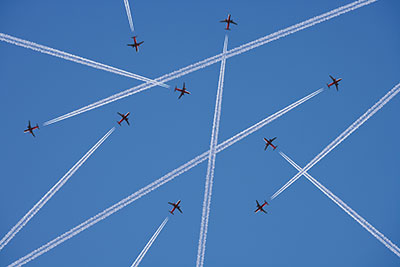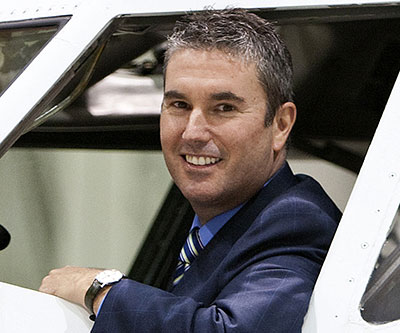
Features
Air Traffic
Monitoring their every movement
Following the disappearance of Malaysia Airlines Flight MH370, the International Civil Aviation Organization (ICAO) convened a special meeting on Global Flight Tracking of Aircraft in Montreal in May, where a consensus was reached among its member states and the international air transport industry sector on the near-term priority to track airline flights, no matter their global location or destination.
September 8, 2014 By Brian Dunn
Following the disappearance of Malaysia Airlines Flight MH370, the International Civil Aviation Organization (ICAO) convened a special meeting on Global Flight Tracking of Aircraft in Montreal in May, where a consensus was reached among its member states and the international air transport industry sector on the near-term priority to track airline flights, no matter their global location or destination. In addition, the meeting established a framework for future efforts in this regard for the medium- and long-term.
 |
|
| In parallel with IATA’s Task Force, ICAO will develop a flight-tracking concept of operations covering how the new tracking data gets shared, with whom, and under what circumstances. |
Under the ICAO framework, contributions by industry through an Aircraft Tracking Task Force (ATTF) coordinated by the International Air Transport Association (IATA) will help address the near-term needs for flight tracking.
“Malaysia Airlines Flight MH370 has been an unprecedented event for aviation and we have responded here in a similarly unprecedented manner,” commented ICAO Council President Olumuyiwa Benard Aliu. “While our flight safety work logically focuses the majority of our energy and resources on accident prevention, everyone in our sector also deeply sympathizes with the families of this lost aircraft’s passengers and crew.”
In parallel with IATA’s Task Force work, ICAO will begin developing a flight-tracking concept of operations covering how the new tracking data gets shared, with whom, and under what circumstances. The UN aviation organization will also begin considering international performance based standards, on a priority basis, to ensure broader adoption of airline flight tracking throughout the aviation system.
Different tracking devices or systems are available from a number of companies, including FLYHT Aerospace Solutions of Calgary, Skytrac Systems of Kelowna, B.C. and Star Navigation Systems of Toronto, which gave a presentation at the Expert Dialogue on Real-time Monitoring of Flight Data Conference in Kuala Lumpur, Malaysia, May 26 and 27. More than 50 industry experts, involving official representatives of several countries, regulatory bodies, airlines and the industry in general, including Airbus and Boeing, attended the conference.
Star’s STAR-A.D.S. system provides accurate, continuous tracking information, relayed through satellite, through minute by minute “heart beats,” giving position, altitude, speed and heading of an aircraft to the airline’s operations centre in addition to real-time Black Box flight data streaming.
The company claims it is the first system in the world to feature in-flight data-analysis, monitoring and diagnostics with a real-time connection between aircraft and the ground. Its real-time capability of tracking performance trends and predicting incident-occurrence enhances aviation safety and improves fleet management while reducing costs for the operator, according to the company. The system also offers fuel management and other operational enhancement benefits that can make the installation of the system a revenue positive one.
Amir Bhatti, Star’s Chief of Technology and a former Certified Aircraft Accident Investigator and Flight Safety Specialist, delivered a presentation entitled, “Real Time Flight Data Monitoring, Tracking and Communication.” He expanded on Star’s views and the benefits of real-time streaming of flight data. And with STC’s for a number of aircraft including 737s, A310s, A340s and more, Bhatti notes that improving global aircraft tracking is not only a safety concern but is also one that is economically viable for airlines. “Yes, it is a safety matter, but it is an operational efficiency as well” to have a STAR-A.D.S.system. In an age where fuel efficiency is paramount, such a system will certainly improve the bottom line.
Eliminating the human error factor
SkyTrac Systems of Kelowna, B.C., has been in the aircraft tracking business for more than 25 years and has solutions that are used on a daily basis for tracking aircraft. While active tracking by dedicated flight-following crews is one solution, it can be time-intensive and prone to human error and oversight. As a result, SkyTrac is encouraging its clients to use passive tracking through “Overdue Notifications,” a simple feature that uses machine-to-machine (M2M) communication technology and supervisory control techniques to its advantage.
This approach reduces the cost and human error associated with traditional flight-following techniques as it relies on connectivity link status to alert flight-following personnel to a possibly serious situation. Because the overdue notification approach is automated, a single supervisor can oversee a large fleet of aircraft with ease.
Overdue notifications are enabled through Skytrac’s web-based flight tracking system management interface (SkyWeb). It automatically alerts assigned individuals via email and uses colour codes and pop-up windows on flight-following software when an aircraft has missed a predefined number of GPS position reports.
Skytrac gives the example of an aircraft that crashed in a remote location and the crew for some reason, was unable to make a distress call or inform ground crew of an in-flight emergency prior to impact. Because the overdue notification feature was enabled, SkyWeb automatically alerted ground crew that there was a potential problem within minutes of the actual accident.
When no response was received from the aircraft, a search and rescue crew was sent out immediately who were able to locate the crash site with minimum time lost.
Improving safety in the harshest conditions
FLYHT’s main product is the Automated Flight Information Reporting System, or AFIRS.
 |
|
| FLYHT president Matt Bradley says the AFIRS system could have pinpointed MH370 right away and eliminated the high costs in searching for the aircraft. Photo: FLYHT
|
The system operates on multiple aircraft types and provides functions such as voice and text messaging, data collection and transmission, and on-demand streaming of black box data. AFIRS sends that information to its companion, UpTime, the ground service product, which stores and transfers the data to the customer in real time. Aircraft operators can use this information to increase safety, improve service, and enhance profitability by tracking engine performance and providing fuel reports among other measures, the company explained.
First Air, based in Yellowknife and Iqaluit, is adding AFIRS and FLYHTStream’s automatically triggered, real-time data and live black box streaming capability to its current fleet of 21 Boeing 737, ATR and Boeing 767 aircraft at a cost of under $100,000 per aircraft.
The airline operates throughout the Canadian Arctic in some of the harshest conditions on earth and as a result is continually striving to find ways to improve the safety and operational efficiency of its fleet.
Enabling FLYHTStream raises the standard of tracking and automated alerting that is unsurpassed in the industry. It’s also a small price to pay compared to the cost of replacing an aircraft costing millions of dollars.
“FLYHT’s Automated Flight Information System (AFIRS) ensures we have 100 per cent visibility on our aircraft at all times,” said Brock Friesen, President and CEO of First Air.
“We are proud to be industry leaders in adopting the FLYHTStream capability to ensure First Air has the highest level of operational awareness available on any aircraft flying today. It is another important step in our continual process of enhancing safety.”
Vic Charlebois, Vice-President of flight operations added, “FLYHTStream will alert us when an aircraft needs assistance, without distracting the crew from the primary task of flying the aircraft safely. Financially, AFIRS has paid for itself by saving First Air tens of thousands of dollars in flight management expenses, and FLYHTStream is only an incremental cost that is incurred when triggered, making the solution very cost effective.”
AFIRS is the hardware on an aircraft, while FLYHTstream is the software, explained FLYHT president Matt Bradley. “AFIRS is designed to provide an alert to the operational control centre if there’s a problem with an aircraft who then may alert air traffic control. If it’s a serious problem, it will stream data from the black box to the control centre.”
Finding ways to fill the void
ICAO’s recommendation of performance-based standards for airline tracking addresses a gap that has been there for a long time, Bradley suggested.
“The public thinks when a plane takes off, it’s visible to Air Traffic Controllers (ATC) all the time. That’s true most of the time, but when the aircraft flies outside of primary radar control (more than 200 miles offshore, for example) ATC relies on secondary surveillance radar or procedural control. Procedural control is prone to error, as was the case when there was a miscommunication with Air France 447 (which crashed into the Atlantic Ocean en route from Rio de Janeiro to Paris in 2009) with another Air France flight over the tail numbers which had 447 descending into the ocean.”
The accident report said the likely cause was the pitot tubes being obstructed by ice crystals, leading to a stall. From FLYHT’s perspective, who knew where the flight went down and what did the public think of existing standards?
If their equipment was on board, Bradley said, it could pinpoint the exact location where the plane went down, eliminating the more than 50 million Euros in costs associated with the search for the aircraft.
In terms of MH370, nobody has designed a system that is 100 per cent tamper proof, said Bradley, who believes the flight’s disappearance may have been caused by an onboard fire, which led to the disabling of some of the plane’s
avionics systems.
“We have designed a system that is tamper resistant and we’ve removed the ability to tamper with it from the cockpit which we could ship out tomorrow. But we are waiting for the recommendations from IATA before we proceed, in case they make recommendations we haven’t considered.”
FLYHT is targeting both airlines and OEM for its products and already has some 300 units on the market used by about 30 commercial operators. And there’s lots of room to grow. There are more than 10,000 commercial aircraft operating today and another 10,000 are expected to be delivered over the next few years from the major manufacturers. Add in 5,000 business jets, and the sky is literally the limit when it comes to growth opportunities for all flight tracking devices.